Key takeaways
- Fotomagico is an intuitive slideshow creation tool tailored for photographers, enhancing image presentation with ease.
- The software offers precise control over timing, transitions, and organization, enabling a storytelling approach to presentations.
- Efficient project workflows are supported by setting milestones, maintaining backups, and consistent naming conventions.
- Sharing and exporting are streamlined, allowing users to quickly publish projects on platforms like Vimeo or YouTube.
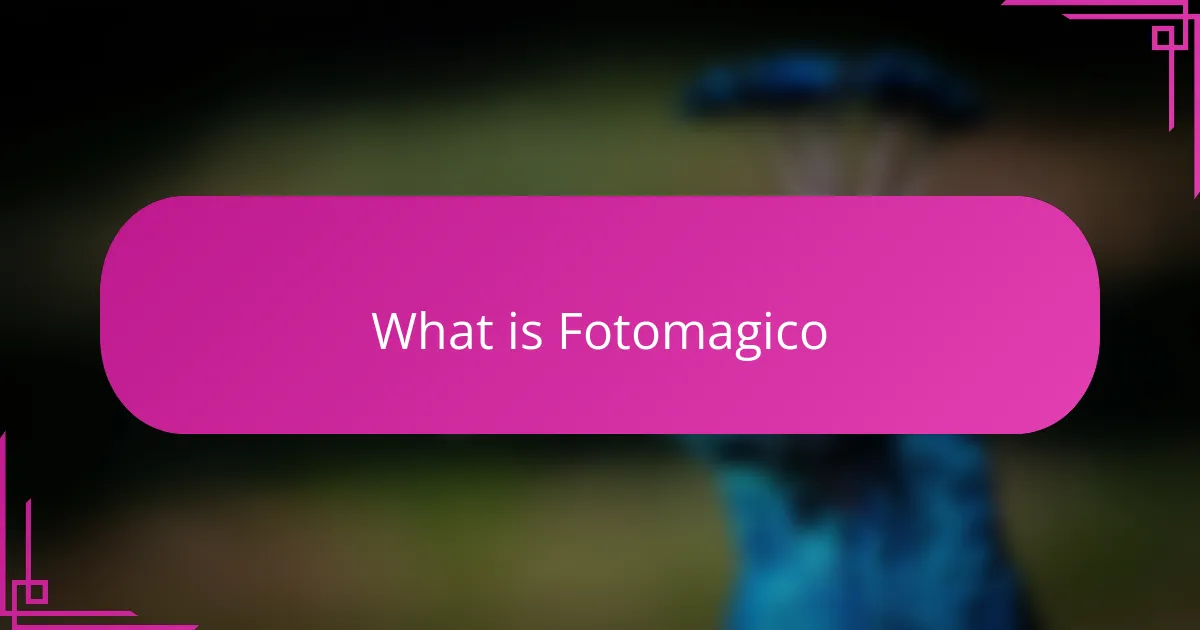
What is Fotomagico
Fotomagico is a slideshow creation software designed especially for photographers who want to present their images in a compelling way. I’ve found it incredibly intuitive, which makes turning a handful of photos into a polished presentation feel almost effortless. Have you ever struggled to share your work in a way that truly captures its essence? That’s exactly where Fotomagico shines.
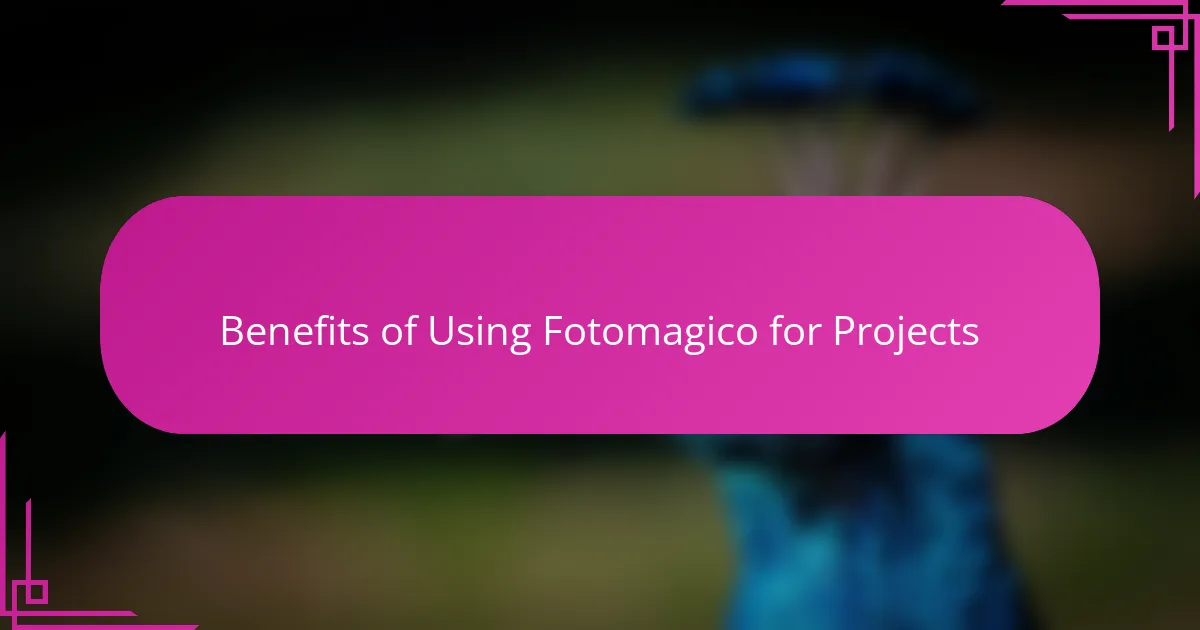
Benefits of Using Fotomagico for Projects
One of the biggest benefits I’ve noticed using Fotomagico is how smoothly it handles complex projects without overwhelming me. The way it layers images, music, and text feels natural, like the software understands the creative flow rather than interrupting it. Have you ever started a slideshow only to get tangled in endless settings? Fotomagico spares you from that frustration.
What really stands out to me is the control I get over timing and transitions. It’s not just a standard slideshow—it’s more like storytelling, where every moment feels intentional. I remember working on a wedding project where syncing the photos to the music perfectly elevated the entire experience for everyone watching. That’s a kind of impact you can only get when the tool lets you fine-tune the details without hassle.
Finally, the way Fotomagico organizes my projects keeps me motivated. Instead of drowning in folders or losing track of edits, I have a neat workspace where everything feels connected. That sense of order has made me more confident to tackle larger, more ambitious presentations, knowing I won’t lose anything important along the way. Wouldn’t you agree that having a reliable system under your creative control changes how you approach your work?
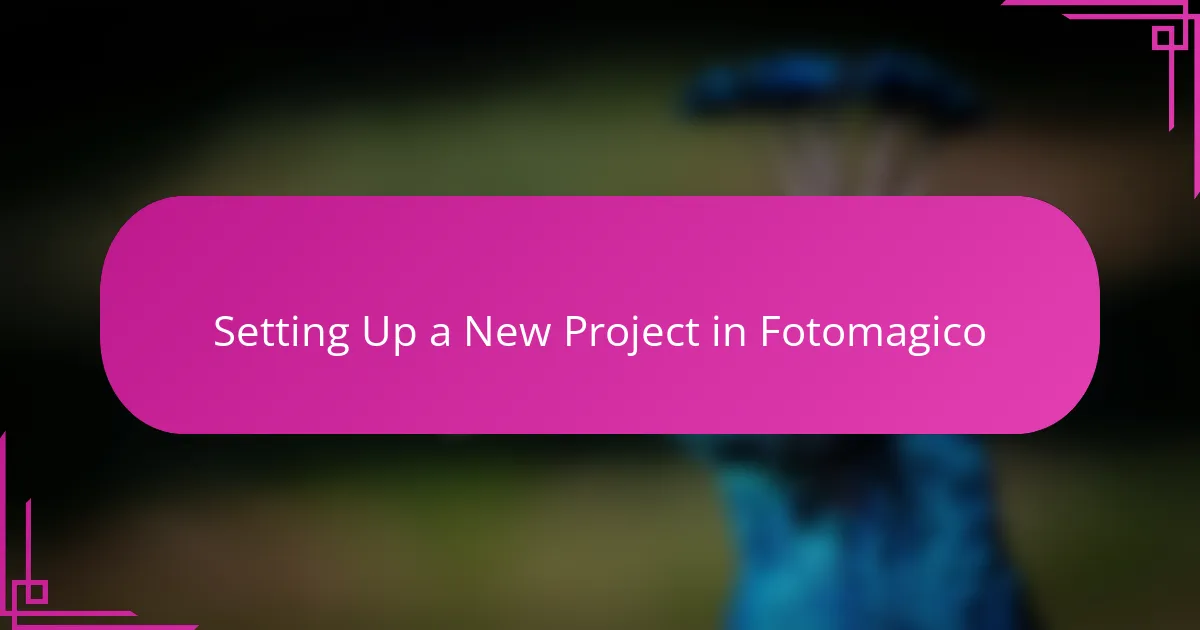
Setting Up a New Project in Fotomagico
When I start a new project in Fotomagico, I usually begin by naming it something clear and specific. It might seem like a small step, but giving your project a thoughtful title helps me stay focused and makes it easier to find later. Have you ever opened a file and immediately forgotten what it was for? This simple habit saves me from that confusion.
Next, I set the dimensions and resolution right away, matching the output with the platform or screen I’m targeting. Fotomagico’s presets are a great time-saver here, but I like tweaking the details to suit each project’s unique needs. It feels reassuring to know that everything is optimized upfront before I dive into adding photos and effects.
What really helps me settle into the creative flow is organizing my imported images right away within the project. I create thematic folders or sequences that match the story I want to tell, which keeps me from feeling scattered as I build the slideshow. Have you noticed how chaos creeps in when you don’t set a clear structure at the start? This step turns that chaos into calm, and I find it easier to experiment and adjust without losing track of anything.
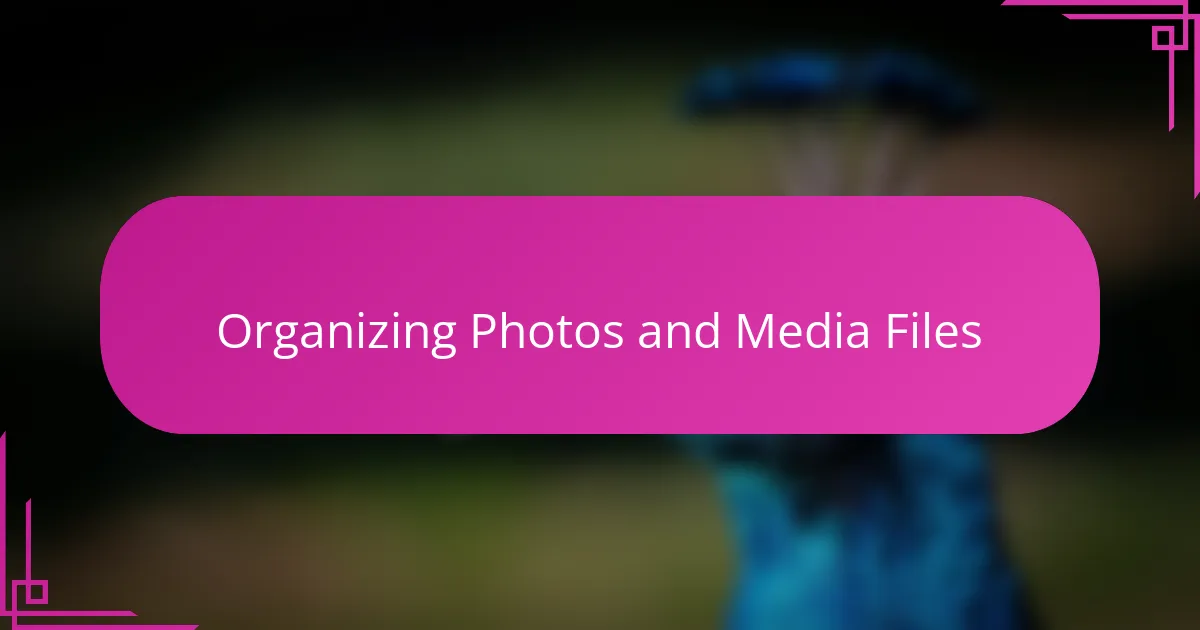
Organizing Photos and Media Files
One thing I’ve learned is that organizing photos and media files before diving into the creative part saves me so much time later. I usually sort images by date or event and tag them with keywords that make sense to me. Have you ever spent half an hour hunting for that one perfect shot? That frustration disappears when your files are arranged thoughtfully from the start.
I also make a habit of separating raw files, edited photos, and supporting media like music or voiceovers into their own folders within the project. This simple step keeps my workspace tidy and reduces the mental clutter that can slow the creative process. It’s funny how a neat file structure can actually boost your motivation, don’t you think?
Sometimes, I catch myself adding random images without a clear plan, only to regret the mess later. So now, I create subfolders that reflect the story beats or themes of the slideshow. This way, every file feels purposeful, and I can easily tweak sequences without scrambling. Have you tried organizing files like chapters in a book? It’s a small change that made a big difference in how I work with Fotomagico.
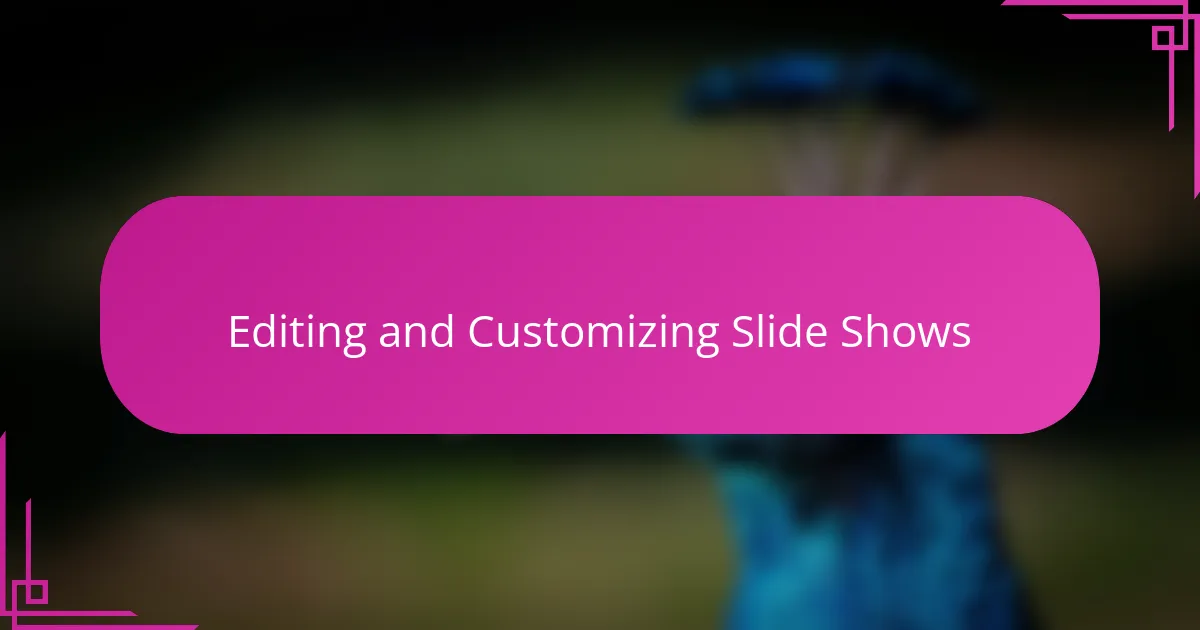
Editing and Customizing Slide Shows
When it comes to editing and customizing slide shows in Fotomagico, I love how the software gives me precise control over every detail. Adjusting the timing of each photo and selecting transitions that match the mood feels like directing a film rather than just creating a slideshow. Have you noticed how a well-timed fade or zoom can completely change the way a story feels? That’s exactly the kind of nuance Fotomagico makes easy to achieve.
One feature I rely on is the ability to add text overlays and mask certain parts of images. It’s those small touches that turn a simple collection of photos into a narrative with emphasis and clarity. I remember working on a travel slideshow where I highlighted landmarks with subtle captions—without cluttering the visual flow. It’s a balancing act, but Fotomagico’s customization options let me find the sweet spot between info and artistry every time.
Another aspect that really impresses me is syncing background music with the slideshow’s pace. I often spend a bit of extra time tweaking slide durations so key photo changes hit right on the beat. Does anyone else find that syncing visuals and music transforms a presentation from good to captivating? For me, this is where Fotomagico truly shines, enabling a seamless blend of sight and sound that keeps audiences engaged from start to finish.
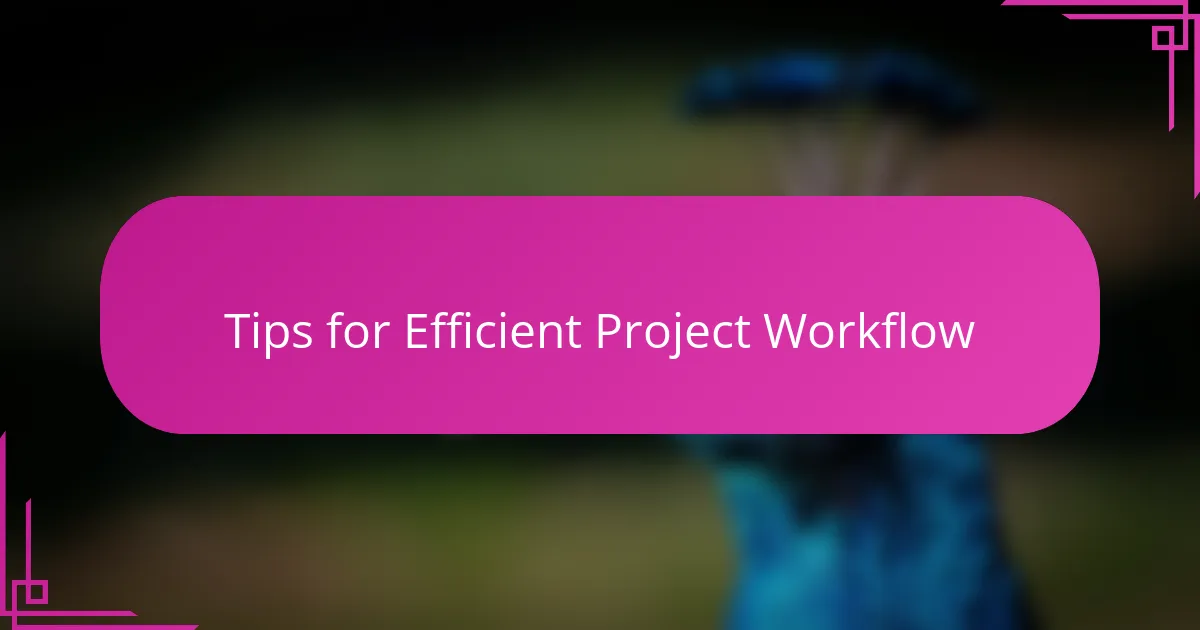
Tips for Efficient Project Workflow
One tip I always follow for an efficient project workflow is setting clear milestones right from the start. Breaking the project into manageable chunks keeps me motivated and prevents that overwhelming “where do I even begin?” feeling. Have you ever noticed how crossing off small goals makes the whole process feel less daunting? It’s a simple trick, but it transforms my workflow into something genuinely enjoyable.
I also make a habit of regularly saving iterations of my project files as I go. It might sound basic, but from experience, it’s saved me from hours of frustration more than once. Imagine investing time in perfecting your slideshow only to lose those tweaks because of a crash or accidental overwrite—trust me, it’s not worth the risk. Keeping backups means I can experiment fearlessly, knowing I have a safety net.
Another thing I focus on is maintaining consistent naming conventions and project notes within Fotomagico. This habit might seem tedious, but it pays off handsomely when I revisit projects after a break or collaborate with others. Doesn’t it feel good to open a project and immediately understand your creative path without puzzling through cluttered filenames or forgotten ideas? That clarity keeps my creative flow smooth and stress-free.
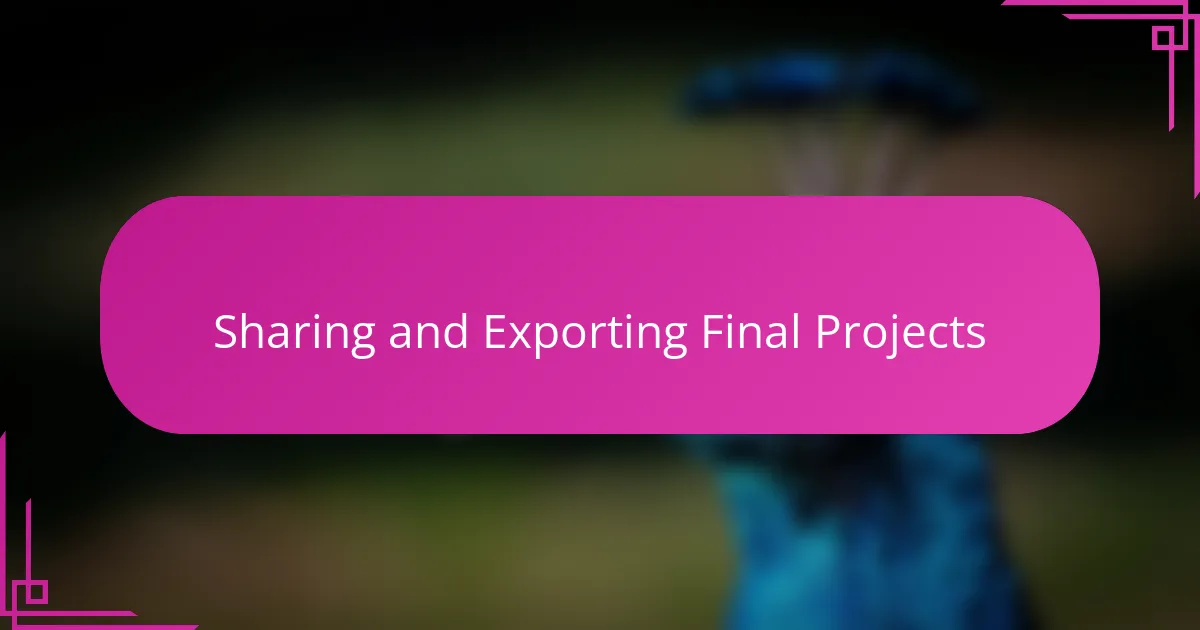
Sharing and Exporting Final Projects
Exporting my final Fotomagico projects feels like sealing a story I’ve carefully crafted. I usually choose the export format based on where I plan to share the slideshow—whether it’s a quick video for social media or a high-resolution file for a client presentation. Have you ever been stuck wondering which format works best? Fotomagico’s export presets take that guesswork away, making it easy to get exactly what I need.
When it’s time to share, I appreciate how seamless the process is. I often export directly to platforms like Vimeo or YouTube right from within Fotomagico, which saves me the hassle of uploading files separately. Plus, having a polished slideshow ready in moments means I can focus on engaging with my audience instead of technical glitches. Isn’t it satisfying to see your work shared professionally without extra stress?
Sometimes, I like to archive my projects with all the source files neatly packaged, especially for important client work. This habit not only keeps my workflow organized but also gives me peace of mind that I can revisit or update the slideshow anytime. Do you keep backup versions of your creative projects? For me, this practice turns the final export into just another step in an ongoing creative journey.